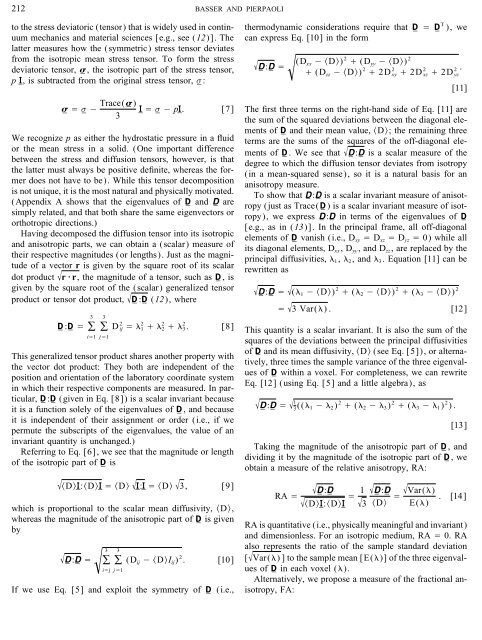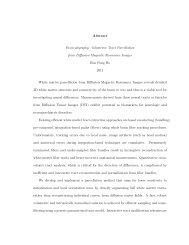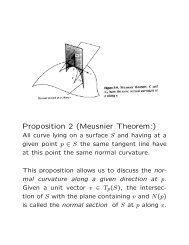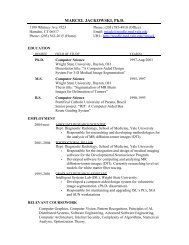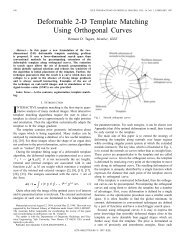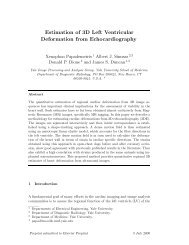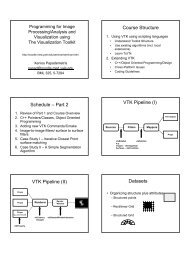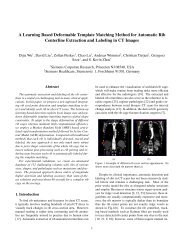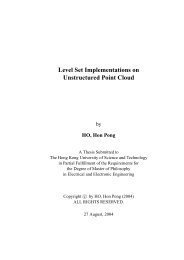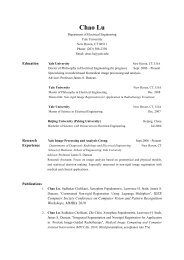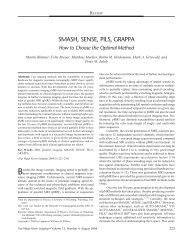Microstructural and Physiological Features of Tissues Elucidated by ...
Microstructural and Physiological Features of Tissues Elucidated by ...
Microstructural and Physiological Features of Tissues Elucidated by ...
You also want an ePaper? Increase the reach of your titles
YUMPU automatically turns print PDFs into web optimized ePapers that Google loves.
212 BASSER AND PIERPAOLI<br />
to the stress deviatoric (tensor) that is widely used in contin- thermodynamic considerations require that DW Å DW T ), we<br />
uum mechanics <strong>and</strong> material sciences [e.g., see (12)]. The can express Eq. [10] in the form<br />
latter measures how the (symmetric) stress tensor deviates<br />
from the isotropic mean stress tensor. To form the stress<br />
<br />
<br />
(Dxx 0 »D…)<br />
DW :DW Å<br />
2 / (Dyy 0 »D…) 2<br />
/ (Dzz 0 »D…) 2 / 2D 2 xy / 2D 2 xz / 2D 2 deviatoric tensor, sW , the isotropic part <strong>of</strong> the stress tensor,<br />
p IW , is subtracted from the original stress tensor, sW :<br />
.<br />
yz<br />
[11]<br />
sW Å sW 0<br />
Trace(sW )<br />
3<br />
IW Å sW 0 pIW . [7] The first three terms on the right-h<strong>and</strong> side <strong>of</strong> Eq. [11] are<br />
the sum <strong>of</strong> the squared deviations between the diagonal elements<br />
<strong>of</strong> DW <strong>and</strong> their mean value, »D…; the remaining three<br />
We recognize p as either the hydrostatic pressure in a fluid<br />
or the mean stress in a solid. (One important difference<br />
between the stress <strong>and</strong> diffusion tensors, however, is that<br />
the latter must always be positive definite, whereas the former<br />
does not have to be). While this tensor decomposition<br />
is not unique, it is the most natural <strong>and</strong> physically motivated.<br />
(Appendix A shows that the eigenvalues <strong>of</strong> DW <strong>and</strong> DW are<br />
simply related, <strong>and</strong> that both share the same eigenvectors or<br />
orthotropic directions.)<br />
Having decomposed the diffusion tensor into its isotropic<br />
<strong>and</strong> anisotropic parts, we can obtain a (scalar) measure <strong>of</strong><br />
their respective magnitudes (or lengths). Just as the magni-<br />
tude <strong>of</strong> a vector r is given <strong>by</strong> the square root <strong>of</strong> its scalar<br />
dot product<br />
terms are the sums <strong>of</strong> thesquares <strong>of</strong> the <strong>of</strong>f-diagonal ele-<br />
ments <strong>of</strong> DW . We see that DW :DW is a scalar measure <strong>of</strong> the<br />
degree to which the diffusion tensor deviates from isotropy<br />
(in a mean-squared sense), so it is a natural basis for an<br />
anisotropy measure.<br />
To show that DW :DW is a scalar invariant measure <strong>of</strong> anisotropy<br />
(just as Trace(DW ) is a scalar invariant measure <strong>of</strong> isot-<br />
ropy), we express DW :DW in terms <strong>of</strong> the eigenvalues <strong>of</strong> DW<br />
[e.g., as in (13)]. In the principal frame, all <strong>of</strong>f-diagonal<br />
elements <strong>of</strong> DW vanish (i.e., Dxy Å Dxz Å Dyz Å 0) while all<br />
its diagonal elements, Dxx, Dyy, <strong>and</strong> Dzz, are replaced <strong>by</strong> the<br />
principal diffusivities, l1, l2, <strong>and</strong> l3. Equation [11] can be<br />
rewritten as<br />
<br />
rrr, the magnitude <strong>of</strong> a tensor, such as DW ,is<br />
given <strong>by</strong> the square root <strong>of</strong> the (scalar) generalized tensor<br />
<br />
DW :DW Å (l1 0 »D…) 2 / (l2 0 »D…) 2 / (l3 0 »D…) 2<br />
product or tensor dot product, <br />
DW :DW (12), where<br />
<br />
Å 3 Var(l) . [12]<br />
3 3<br />
DW :DW Å ∑ ∑ D<br />
iÅ1 jÅ1<br />
2 ij Å l 2 1 / l 2 2 / l 2 3. [8]<br />
This quantity is a scalar invariant. It is also the sum <strong>of</strong> the<br />
squares <strong>of</strong> the deviations between the principal diffusivities<br />
This generalized tensor product shares another property with<br />
the vector dot product: They both are independent <strong>of</strong> the<br />
position <strong>and</strong> orientation <strong>of</strong> the laboratory coordinate system<br />
in which their respective components are measured. In par-<br />
<strong>of</strong> DW <strong>and</strong> its mean diffusivity, »D… (seeEq. [5]), or alternatively,<br />
three times the sample variance <strong>of</strong> the three eigenval-<br />
ues <strong>of</strong> DW within a voxel. For completeness, we can rewrite<br />
Eq. [12] (using Eq. [5] <strong>and</strong> a little algebra), as<br />
ticular, DW :DW (given in Eq. [8]) is a scalar invariant because <br />
1<br />
DW :DW Å 3((l1 0 l2) 2 / (l2 0 l3) 2 / (l3 0 l1) 2 it is a function solely <strong>of</strong> the eigenvalues <strong>of</strong> DW , <strong>and</strong> because<br />
).<br />
it is independent <strong>of</strong> their assignment or order (i.e., if we<br />
permute the subscripts <strong>of</strong> the eigenvalues, the value <strong>of</strong> an<br />
[13]<br />
invariant quantity is unchanged.)<br />
Referring to Eq. [6], we seethat the magnitude or length<br />
<strong>of</strong> the isotropic part <strong>of</strong> DW is<br />
Taking the magnitude <strong>of</strong> the anisotropic part <strong>of</strong> DW , <strong>and</strong><br />
dividing it <strong>by</strong> the magnitude <strong>of</strong> the isotropic part <strong>of</strong> DW ,we<br />
obtain a measure <strong>of</strong> the relative anisotropy, RA:<br />
<br />
<br />
<br />
»D…IW :»D…IW Å »D… IW :IW Å »D… 3, [9]<br />
RA Å<br />
<br />
DW :DW<br />
<br />
»D…IW :»D…IW Å 1 <br />
3<br />
<br />
DW :DW<br />
»D… Å<br />
<br />
Var(l)<br />
. [14]<br />
E(l)<br />
which is proportional to the scalar mean diffusivity, »D…,<br />
whereas the magnitude <strong>of</strong> the anisotropic part <strong>of</strong> DW is given RA is quantitative (i.e., physically meaningful <strong>and</strong> invariant)<br />
<strong>by</strong><br />
<br />
<br />
DW :DW Å<br />
3<br />
∑<br />
iÅj<br />
3<br />
∑ (Dij 0 »D…I ij)<br />
jÅ1<br />
2 . [10]<br />
If we use Eq. [5] <strong>and</strong> exploit the symmetry <strong>of</strong> DW (i.e.,<br />
<strong>and</strong> dimensionless. For an isotropic medium, RA Å 0. RA<br />
also represents the ratio <strong>of</strong> the sample st<strong>and</strong>ard deviation<br />
[ <br />
Var(l) ] to the sample mean [E(l)] <strong>of</strong> the three eigenvalues<br />
<strong>of</strong> DW in each voxel (l).<br />
Alternatively, we propose a measure <strong>of</strong> the fractional anisotropy,<br />
FA:


